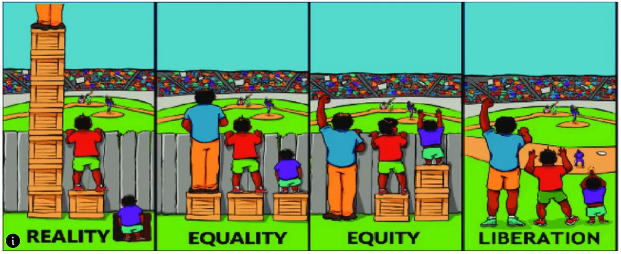What is Accessible Pedagogy?
Accessible Pedagogy can be built into every component of how we teach, from course design to assessment practices. Weaving together Universal Design for Learning (UDL) with intersectional approaches to disability and access, as well as other equity-oriented frameworks, allows us to consider the needs of a variety of different learners so that everyone can learn how they learn best.
We consider accessibility because we want all students to learn. Even more, we want all students to feel valued, respected, and connected while they are learning. This is important because it’s what each learner deserves, but also because all learners learn better when they feel that way. Every student has a right to equitable access to education, and every student learns best when the unique way their body and mind works is appreciated and anticipated in the classroom environment. Learn more about the AODA Education Standards.
Image description: An illustrative four-panel image representing the concepts of Reality, Equality, Equity, and Liberation in the context of viewing a baseball game. In the ‘Reality’ panel, three individuals of different heights struggle to see over a fence; only the tallest can see clearly. The ‘Equality’ panel shows each individual standing on identical boxes, yet the shortest still can’t see. The ‘Equity’ panel adjusts the box heights so all can see the game equally. Finally, the ‘Liberation’ panel removes the fence entirely, allowing an unobstructed view for all. This image serves as a powerful metaphor for social justice and the removal of systemic barriers.
Image Credit: A collaboration between Center for Story-based Strategy & Interaction Institute for Social Change.
Considering Accessibility in Teaching and Learning
Accessible Pedagogy weaves together principles of Universal Design for Learning with other equity-oriented frameworks, inspired by some of the interventions made by disability justice. This work is happening across the college in different ways. Throughout the Accessible Pedagogy pages, we feature some equity-oriented strategies that will help you prioritize intersectional forms of access in your teaching.
Doing this benefits everybody: when we consider accessibility in our classroom, more of our students will be able to understand and remember what we’re teaching, show engagement in classroom activities, share their prior knowledge and demonstrate the new knowledge they are gaining, and more students will be able to contribute respectfully to their classroom community.
Within the Accessible Pedagogy pages, you will find general information and tips for considering accessibility in learning spaces (physical and digital) and facilitation of those spaces. We’re hoping these ideas and strategies will inspire you, deepen your commitment to accessibility, and challenge the myth of the “average” student. There will also be information on considering individual access needs and incorporating them into general accessibility considerations.
The “Plus One” Approach
After reading these strategies, if you are not sure where to begin, we recommend a “plus one” mindset – what is one thing you could start straight away? You don’t need to make major changes all at once, or overhaul an entire course. Your own needs and capacity are important to consider as you begin making small adjustments that will be sustainable for you.
So try starting here: is there one concept, idea, or strategy you are curious about? What type of planning and support might you need in order to make these adjustments? On each page, you will find context as to the “why” behind these strategies, as well as practical examples on “how” to incorporate them into your own practice.
Go Further
The “Go Further” sections provide additional resources, strategies, and information to delve deeper into different aspects of your classroom practices, equity-oriented frameworks, and anti-oppressive practices. You can consider making an appointment with someone in the TLX based on the topics you are most interested in “going further” on.
Just in Time Videos
Accessible Learning Services
Join Mandy, an Accessibility Consultant at George Brown, as she discusses accommodations and accessibility in the classroom.
Accessible Powerpoints
Watch as Joanna Friend, Professor from the School of Early Childhood, explains how to make the most out of your learning resources to help students stay engaged and feel included.
Unlock the Power of Inclusive Education
WHY?
When we prioritize accessibility in our classroom facilitation, we open doors for more students to grasp and retain what we're teaching, engage actively in class, share their knowledge, and contribute meaningfully to the classroom community. Learn why accessibility is crucial for fostering a supportive and effective learning environment.
HOW?
Discover practical strategies to create an inclusive classroom guided by three key teaching priorities: challenging exclusionary norms, building flexibility into learning activities, and recognizing past exclusion experiences. Explore actionable steps and ideas to cultivate trust, offer choices, ensure predictability, and engage diverse learners. Start your journey towards a more inclusive, welcoming, and respectful classroom today.

